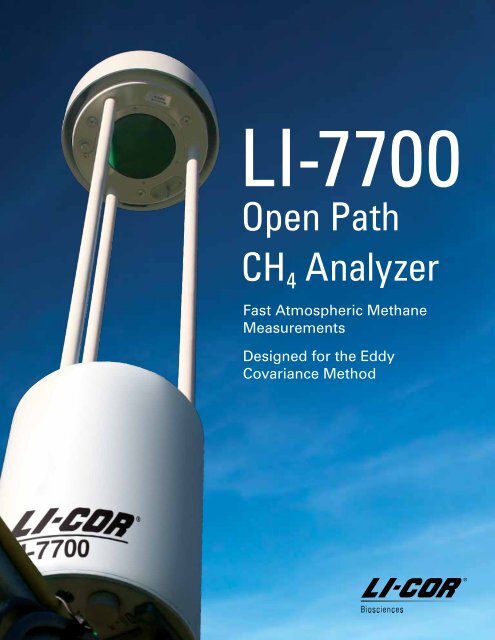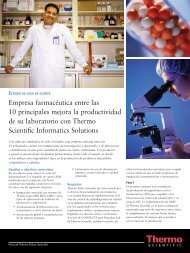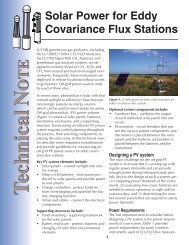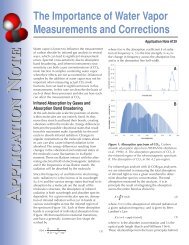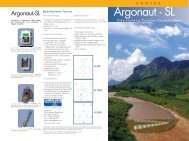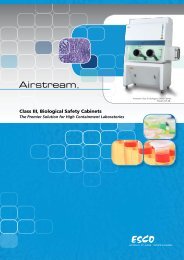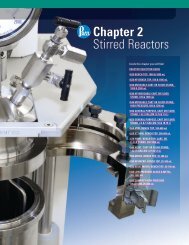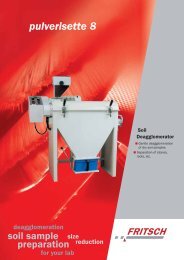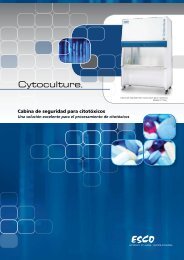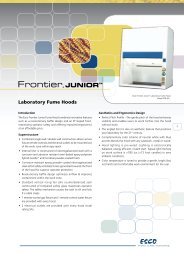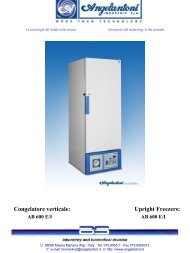Open Path CH4 Analyzer - LI-COR
Open Path CH4 Analyzer - LI-COR
Open Path CH4 Analyzer - LI-COR
- No tags were found...
You also want an ePaper? Increase the reach of your titles
YUMPU automatically turns print PDFs into web optimized ePapers that Google loves.
The <strong>LI</strong>-7700 <strong>Open</strong> <strong>Path</strong> CH 4 <strong>Analyzer</strong> - Advantages Page 1Innovative SolutionsRemote Field Deployment• Low power (8 W duringnormal operation)• Light weight (5.2 kg)• Low maintenance• Designed for long-term,unattended, continuousoperationEddy Covariance• High precision (5 ppb RMSnoise @ 10 Hz, 2000 ppb CH 4 )• High-speed data output(up to 40 Hz)• Simplified data integration• Analog inputs for sonicanemometer data<strong>Open</strong> <strong>Path</strong>• In-situ methane densitymeasurement using laserspectroscopy• Enables low power systemoperation• No time delays or attenuationfrom tubing• No pump requiredDesigned for Field Use• Radiation shield minimizescondensation on the uppermirror• Carbon fiber spars minimizethermal expansion of theoptical path• Heaters keep mirrors nearambient temperature toprevent condensationSelf-Cleaning Lower Mirror• Decreases maintenancerequirements• Ensures more robust,continuous data setswasherfluid• Cleaning is initiated atuser-specified time intervalsor a signal strength thresholdGo to www.licor.com/mirror to watch avideo of the <strong>LI</strong>-7700’s self-cleaning mirror
The <strong>LI</strong>-7700 <strong>Open</strong> <strong>Path</strong> CH 4 <strong>Analyzer</strong> - Advantages Page 2The <strong>LI</strong>-7700 <strong>Open</strong> <strong>Path</strong> CH 4 <strong>Analyzer</strong>The <strong>LI</strong>-7700 makes in-situ measurement ofmethane density with the resolution, speed,and stability required for the eddy covariancetechnique.Previously, measuring methane flux was difficultbecause of instrument limitations, including highpower demands, heavy pumps, and the need forinstrument enclosures. The <strong>LI</strong>-7700 overcomesall of these limitations.The <strong>LI</strong>-7700 is light weight, has low powerrequirements, and provides high frequencyresponse. The <strong>LI</strong>-7700 is designed to measuremethane density at frequencies that are necessaryto quantify ecosystem methane flux.Why the <strong>LI</strong>-7700?• High precision and accuracy• Low power• Long-term, low maintenanceoperation• Easily integrates into flux towers• Simplified data integration• Light weightMeasure CH 4 EverywhereRice paddies, bogs, wetlands, and othermethane-producing ecosystems are unforgivingplaces for scientific instrumentation. The<strong>LI</strong>-7700 <strong>Open</strong> <strong>Path</strong> CH 4 <strong>Analyzer</strong> is designed foruse in these remote environments.Methane flux data has been collected with the<strong>LI</strong>-7700 in a variety of ecosystems under a widerange of environmental conditions - from Arctictundra to mangrove forests.The <strong>LI</strong>-7700 includes numerous innovations thatreduce the need for site visits, while enablingthe collection of continuous, long-term data setsin remote locations.The open path design eliminates the need forpumps and tubing. Unlike closed path systems,there are no pressure drops, tubing attenuation,or time delays with open path systems.<strong>LI</strong>-<strong>COR</strong> recognizes field instruments require adurability that bench-top instruments often lack.The <strong>LI</strong>-7700 is designed to make high qualitymeasurements in extreme environments.Florida Everglades
The <strong>LI</strong>-7700 <strong>Open</strong> <strong>Path</strong> CH 4 <strong>Analyzer</strong> - Advantages Page 3Low Power… to go where you need to go.Methane-emitting ecosystems tend to occur inregions that lack easy access to AC power.This complicates measurements of ecosystem methaneflux. The <strong>LI</strong>-7700 is designed for DC (battery andsolar panel) operation in remote areas and extremeenvironments. This provides you the freedom to takethe instruments wherever you want to measure, withoutbeing constrained by power requirements.
The <strong>LI</strong>-7700 <strong>Open</strong> <strong>Path</strong> CH 4 <strong>Analyzer</strong> - Advantages Page 4Enhanced Ethernet CapabilitiesThe <strong>LI</strong>-7700 provides Ethernet data output that allows for quick, easy connectivity to a computer ornetwork. Ethernet connectivity allows you to monitor your instruments remotely, adjust instrumentsettings, and transfer data files over network connections when configured with <strong>LI</strong>-<strong>COR</strong>’s CO 2 /H 2 Oanalyzers in GHG packages. Ethernet also facilitates remote data links through cellular modemswhich brings a new level of connection to remote field sites.Simplified Data CollectionThe <strong>LI</strong>-7700 accepts four analoginput channels for sonic anemometerdata, and outputs a single datastream via the Ethernet connection.With the <strong>LI</strong>-7550 <strong>Analyzer</strong> InterfaceUnit data is stored on a removable,industrial-grade USB flash drive(4 GB drive included with <strong>LI</strong>-7550).Time Methane Density Sonic Anemometer(mmol m -3 ) u (m s -1 ) v (m s -1 ) w (m s -1 ) T (ºC)14:22:15.4 0.08293 -0.87 -1.08 -0.11 22.9714:22:15.5 0.08433 -0.86 -1.08 -0.01 22.9014:22:15.6 0.08436 -0.82 -1.01 0.00 22.8714:22:15.7 0.08386 -0.86 -0.94 0.18 22.8814:22:15.8 0.08326 -0.91 -0.96 0.17 22.9114:22:15.9 0.08458 -0.86 -1.11 0.16 22.8814:22:16.0 0.08289 -0.72 -1.26 -0.01 22.8514:22:16.1 0.08275 -0.70 -1.17 -0.02 22.8214:22:16.2 0.08296 -0.79 -0.98 0.14 22.91Intuitive Windows InterfaceSignal from sonic anemometer is merged with methane data.The Windows ® interface software (included) makes set-up and configuration as simple as possible. Itprovides full control over logging configuration options, auxiliary inputs, and data output. Configurationof mirror heaters and cleaning settings is made easy with the graphical controls. The auto-scaling interfacewindow is designed for viewing on netbook computer displays as well as desktop monitors.Using the <strong>LI</strong>-7700’s Ethernetcapabilities, a <strong>LI</strong>-<strong>COR</strong>scientist monitors real-timedata from instruments setup at the Bluff RoadMunicipal Solid WasteLandfill near Lincoln, NE.
The <strong>LI</strong>-7700 <strong>Open</strong> <strong>Path</strong> CH 4 <strong>Analyzer</strong> - Technology Page 6Advantages of WMS• Strong signal with low noise• Reduced sensitivity tocontamination of mirrors• Short physical path length• Operation at ambientpressureThe green laser shown at theright is for the purpose of illustrationonly. The <strong>LI</strong>-7700 uses anear-infrared laser source that isinvisible to the human eye.The <strong>LI</strong>-7700 was selectedby R&D Magazine as oneof the 100 most innovative,technologically significantproducts of 2010.
The <strong>LI</strong>-7700 <strong>Open</strong> <strong>Path</strong> CH 4 <strong>Analyzer</strong> - Field Data Page 7Field DataThe figure below shows an example of methane flux data from a 23-day period over the Florida Evergladesat a height of 3.15 m. Under high humidity conditions, the <strong>LI</strong>-7700 collected data continuouslywith very little user-intervention. Fluxes were obtained with the eddy covariance method using the<strong>LI</strong>-7700 and a sonic anemometer. The inset shows hourly averages of data collected over a single24-hour period. In this example, reduced wind speeds in the evenings led to lower turbulent exchangeand allowed methane to accumulate in the canopy. Each morning, the build-up was eliminated as windspeeds increased.2.50CH 4concentration, ppm2.252.001.751.506:00 12:00 18:003.050CH 4 Flux, mg m -2 h -1CH 4Concentration, ppm1.50.0-1.5403020Air Temperature, o C-3.01011/19 11/21 11/23 11/25 11/27 11/29 12/1 12/3 12/5 12/7 12/9 12/11Publications which include the <strong>LI</strong>-7700 :McDermitt, D., G. Burba, L. Xu, T. Anderson, A. Komissarov, J. Schedlbauer, D. Zona , W. Oechel, S.Oberbauer, G. Starr, and S. Hastings, 2010. A New Low-Power, <strong>Open</strong> <strong>Path</strong> Instrument for MeasuringMethane Flux by Eddy Covariance. Applied Physics B: Lasers and Optics. Accepted.Burba, G., L. Xu, J. Schedlbauer, D. Zona, T. Anderson, D.K. McDermitt, S. Oberbauer, W. Oechel,A. Komissarov, and B. Riensche, 2010. Eddy Covariance Measurements of Methane Flux at RemoteSites with New Low-Power Lightweight Fast Gas <strong>Analyzer</strong>. European Geosciences Union GeneralAssembly, Vienna, Austria, 02 – 07 May.Pages 46-52 in the following publication:Burba, G.G., and D.J. Anderson, 2010. A Brief Practical Guide to Eddy Covariance Flux Measurements:Principles and Workflow Examples for Scientific and Industrial Applications. <strong>LI</strong>-<strong>COR</strong> Biosciences,Lincoln, USA, Hardbound and Softbound Editions, 212 pp.Go online for more publications: www.licor.com/7700publications
The <strong>LI</strong>-7700 <strong>Open</strong> <strong>Path</strong> CH 4 <strong>Analyzer</strong> - Field Data Page 8Co-spectraCo-spectral analysis provides a powerful toolto evaluate the capability of the analyzer todetect gas fluctuations over a range of frequencies(Kaimal et al., 1972). It is importantto validate frequency response of any newanalyzer, open-path or closed-path, usingactual field data, and compare it to co-locatedreferences such as a sonic anemometer or anopen-path gas analyzer (e.g., <strong>LI</strong>-7500).Sometimes it is also useful to compare theactual co-spectral shapes to ideal ones froma model. However, the modeled shapesmay not always account for specificities andimperfections of study site topography andairflows, while sonic anemometer temperatureflux co-spectra generally do account forthese and are a practical reference of nearlyperfectfrequency response.The figures to the right show ensembleaverages of normalized daytime co-spectraplotted versus non-dimensional frequency forcontrasting ecosystems and measurementheights at a 10 Hz sampling rate.Normalized co-spectra, nC wx /W’X’In all cases, methane co-spectra behavedsimilarly to the co-spectra of CO 2 , H 2 O, andair temperature. This demonstrates that the<strong>LI</strong>-7700 configuration is suitable for measuringfluctuations in CH 4 concentration acrossthe whole spectrum of frequencies thatcontributed to turbulent transport at thesemeasurement heights.All the co-spectra followed the Kaimal model(Kaimal et al., 1972).Kaimal J., J. Wyngaard, U. Izui, and O. Cote.1972. Spectral characteristics of surface-layerturbulence. Quart. J. Roy. Meteor. Soc, 98:563-589.Non-dimensional frequency, f=nz/Uw’T’ w’CO 2 w’CH 4 TDLSKaimal slopeExpected instrument slope at highfrequencyField data illustrate that the<strong>LI</strong>-7700 has the frequencyresponse required to sample therange of eddy frequencies thatcontribute to methane flux.
The <strong>LI</strong>-7700 <strong>Open</strong> <strong>Path</strong> CH 4 <strong>Analyzer</strong> - Eddy Covariance System Page 93-Gas Eddy Covariance SystemFor a multi-gas system, the <strong>LI</strong>-7550 <strong>Analyzer</strong> Interface Unit can be used to integrate an <strong>LI</strong>-7700, aCO 2 /H 2 O analyzer such as the <strong>LI</strong>-7500A <strong>Open</strong> <strong>Path</strong> CO 2 /H 2 O <strong>Analyzer</strong> or <strong>LI</strong>-7200 Enclosed CO 2 /H 2 O<strong>Analyzer</strong> and a sonic anemometer. When using the <strong>LI</strong>-7700 to calculate methane flux, it is criticalthat a high speed H 2 O analyzer be used for water vapor correction.The figure below shows methane, carbon dioxide, and latent heat fluxes measured with the eddycovariance technique over the Florida Everglades. These data are a subset of a 6-week data setcollected during the winter of 2008-09, at 3.15 m above the canopy, using an <strong>LI</strong>-7500 <strong>Open</strong> <strong>Path</strong>CO 2 /H 2 O <strong>Analyzer</strong> and an <strong>LI</strong>-7700 <strong>Open</strong> <strong>Path</strong> CH 4 <strong>Analyzer</strong>. They show a net negative flux of CO 2 ,but positive CH 4 and LE fluxes for the measurement period, indicating that this ecosystem was a sinkof carbon dioxide and a source of methane and water vapor.CH 4Flux (mg/m 2 /h)CO 2Flux (g/m 2 /h)5.0 0.31202.5 0.150-2.5 -0.15-5.0 -0.3-120338 339 340 341 342 343 344 345 346Day of Year600-60LE (W/m 2 )Both the <strong>LI</strong>-7700 <strong>Open</strong> <strong>Path</strong> CH 4 <strong>Analyzer</strong> and the <strong>LI</strong>-7550 <strong>Analyzer</strong> Interface Unit provide fourgeneral ±5 V inputs for analog data from any fast sonic anemometer. The <strong>LI</strong>-7700 also provides threetype E thermocouple inputs for recording additional temperature data if desired. <strong>LI</strong>-<strong>COR</strong> sonic anemometercables (optional) allow you to easily integrate analog data from Gill WindMaster/Pro orCampbell ® Scientific CSAT-3 sonic anemometers with the <strong>LI</strong>-7700 data stream. Weatherproof cableterminals provide simple and reliable electrical connections.Greenhouse Gas Pacakges from <strong>LI</strong>-<strong>COR</strong>:Greenhouse gas analyzer systems from <strong>LI</strong>-<strong>COR</strong> Biosciences facilitate the collection of eddy covariancedata sets by logging CH 4 , CO 2 , and H 2 O density data, along with wind speed, direction, andtemperature data (u, v, w, and T s ) to a removable USB data storage device. Data can also be transferredvia Ethernet to an external data storage device or computer network.<strong>LI</strong>-<strong>COR</strong> offers two Greenhouse Gas Packages which include the <strong>LI</strong>-7700 CH 4 <strong>Analyzer</strong> with eitherthe <strong>LI</strong>-7500A <strong>Open</strong> <strong>Path</strong> CO 2 /H 2 O <strong>Analyzer</strong> or <strong>LI</strong>-7200 Enclosed CO 2 /H 2 O <strong>Analyzer</strong>. Sonic anemometerscan also be purchased from <strong>LI</strong>-<strong>COR</strong>.
For use with:• <strong>LI</strong>-72 0 CO2/H2O <strong>Analyzer</strong>• <strong>LI</strong>-75 0A CO2/H2O• <strong>LI</strong>- 7 0 <strong>CH4</strong> <strong>Analyzer</strong>The <strong>LI</strong>-7700 <strong>Open</strong> <strong>Path</strong> CH 4 <strong>Analyzer</strong> - Eddy Covariance System Page 10Typical Eddy Covariance ConfigurationCH 4 <strong>Analyzer</strong>Integrates easily into new or existing towers.CO 2 /H 2 O <strong>Analyzer</strong><strong>LI</strong>-<strong>COR</strong>’s <strong>LI</strong>-7500A <strong>Open</strong> <strong>Path</strong> <strong>Analyzer</strong> (shown in thediagram) and <strong>LI</strong>-7200 Enclosed <strong>Analyzer</strong> make precise,accurate, and fast measurements. A CO 2 /H 2 O analyzeris a core component of a flux tower.Sonic AnemometerMeasures wind speed and direction. <strong>LI</strong>-<strong>COR</strong>’s flexiblesystem allows for the integration of any sonic anemometerthat has analog outputs.The <strong>LI</strong>-7550 <strong>Analyzer</strong> Interface UnitUsed for data acquisition from the <strong>LI</strong>-7700, as well as dataacquisition and control of the sonic anemometer and CO 2 /H 2 Oanalyzer. Data can be output through Ethernet, or stored internallyon a removable industrial-grade USB drive.7700-101 Washer Assembly (included)Supplies washer fluid for automated washingof lower mirror surface.Solar PanelsWith low power requirements (nominally 8W for <strong>LI</strong>-7700, 20Wfor <strong>LI</strong>-7700 and <strong>LI</strong>-7500A), <strong>LI</strong>-<strong>COR</strong>’s system can be easilyoperated on solar panels and batteries.


